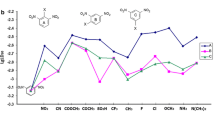Abstract
A quantitative structure-activity relationship model for prediction of mutagenicity of nitronaphthalenes and methylnitronaphthalenes was developed using some fundamental quantum chemical descriptors. The cumulative cross-validated regression coefficient value for the optimal quantitative structure-activity relationship model is 0.711, showing a good predictive capability for mutagenicity of nitronaphthalenes and methylnitronaphthalenes. Results from this study indicate that mutagenicity of nitronaphthalenes and methylnitronaphthalenes increases with increasing frontier molecular orbital energy value, i.e., the sum of the energy of the highest occupied molecular orbital and the energy of the lowest unoccupied molecular orbital, or decreasing the energy of the second highest occupied molecular orbital, final heat of formation, and core–core repulsion energy values.
Similar content being viewed by others
References
Atkinson R, Arey J (1994) Atmospheric chemistry of gas phase polycyclic aromatic-hydrocarbons-formation of atmospheric mutagens. Environ Health Perspect 102:117–126. doi:10.2307/3431940
Bamford HA, Baker JE (2003) Nitro-polycyclic aromatic hydrocarbon concentrations and sources in urban and suburban atmospheres of the mid-Atlantic region. Atmos Environ 37:2077–2091. doi:10.1016/S1352-2310(03)00102-X
Bieler CA, Arlt VM, Wiessler M, Schmeiser HH (2003) DNA adduct formation by the environmental contaminant 3-nitrobenzanthrone in V79 cells expressing human cytochrome P450 enzymes. Cancer Lett 200:9–18. doi:10.1016/S0304-3835(03)00418-X
Chen JW, Quan X, Yan Y, Yang FL, Peijnenburg WJGM (2001) Quantitative structure-property relationship studies on direct photolysis of selected polycyclic aromatic hydrocarbons in atmospheric aerosol. Chemosphere 42:263–270. doi:10.1016/S0045-6535(00)00077-1
Cronin MTD, Gregory BW, Schultz TW (1998) Quantitative structure-activity analyses of nitrobenzene toxicity to Tetrahymena pyriformis. Chem Res Toxicol 11:902–908. doi:10.1021/tx970166m
Dearden JC, Cronin MTD, Schultz TW, Lin DT (1995) QSAR study of the toxicity of nitrobenzenes to Tetrahymena pyriformis. Quant Struct Act Relat 14:427–432. doi:10.1002/qsar.19950140503
Deneer JW, Sinnige TL, Seinen W, Hermens JLM (1987) Quantitative structure-activity relationships for the toxicity and bioconcentration factor of nitrobenzene derivatives towards the guppy (Poecilia reticulata). Aquat Toxicol 10:115–129. doi:10.1016/0166-445X(87)90018-X
Deneer JW, van Leeuwen CJ, Seinen W, Maas-Diepeveen JL, Hermens JLM (1989) QSAR study of the toxicity of nitrobenzene derivatives toward Daphnia magna, Chlorella pyrenoidosa, and Photobacterium phosphoreum. Aquat Toxicol 15:83–98. doi:10.1016/0166-445X(89)90007-6
Durant JL, Busby WF, Lafleur AL, Penman BW, Crespi CL (1996) Human cell mutagenicity of oxygenated, nitrated and unsubstituted polycyclic aromatic hydrocarbons associated with urban aerosols. Mutat Res Genet Toxicol 371:123–157. doi:10.1016/S0165-1218(96)90103-2
Faucon JC, Bureau R, Faisant J, Briens F, Rault S (1999) Prediction of the fish acute toxicity from heterogeneous data coming from notification files. Chemosphere 38:3261–3276. doi:10.1016/S0045-6535(98)00558-X
Gramatica P, Pilutti P, Papa E (2007) Approaches for externally validated QSAR modeling of nitrated polycyclic aromatic hydrocarbon mutagenicity. SAR QSAR Environ Res 18:169–178. doi:10.1080/10629360601054388
Hanna S, Jana H, Vladimir K, Barbara S, Anton K, Mieczyslaw WO, Mats T, Per-Anders B (2004) PAHs and nitrated PAHs in air of five European countries determined using SPMDs as passive samplers. Atmos Environ 39:1627–1640
Hasegawa K, Funatsu K (1998) GA strategy for variable selection in QSAR studies: GAPLS and D-optimal designs for predictive QSAR model. J Mol Struct (Theochem) 425:255–262. doi:10.1016/S0166-1280(97)00205-4
Hien TT, Thanh LT, Kameda T, Takenaka N, Bandow H (2007) Nitro-polycyclic aromatic hydrocarbons and polycyclic aromatic hydrocarbons in particulate matter in an urban area of a tropical region: Ho Chi Minh City, Vietnam. Atmos Environ 41:7715–7725. doi:10.1016/j.atmosenv.2007.06.020
Luan F, Ma WP, Zhang XY, Zhang HX, Liu MC, Hu ZD, Fan BT (2006) Quantitative structure-activity relationship models for prediction of sensory irritants (log RD 50) of volatile organic chemicals. Chemosphere 63:1142–1153. doi:10.1016/j.chemosphere.2005.09.053
McDonald JD, Eide I, Seagrave JC, Zielinska B, Whitney K, Lawson DR, Mauderly JJ (2004) Relationship between Composition and Toxicity of Motor Vehicle Emission Samples. Environ Health Perspect 112:1527–1538
Mohan CG, Gandhi T, Garg D, Shinde R (2007) Computer-assisted methods in chemical toxicity prediction. Mini Rev Med Chem 7:499–507. doi:10.2174/138955707780619554
Niu JF, Yu G (2004) Prediction of the ability of PAHs to be photocytotoxic to a cell line from the rainbow trout (Oncorhynchus mykiss) gill. Bull Environ Contam Toxicol 73:659–665
Őberg T (2005) A QSAR for the hydroxylradicalreaction rate constant: validation, domain of application, and prediction. Atmos Environ 39:2189–2200. doi:10.1016/j.atmosenv.2005.01.007
Pamela G, William PH, Janet A (1996) The contribution of nitro- and methylnitro-naphthalenes to the vapor-phase mutagenecity of ambient air samples. Atmos Environ 30:3157–3166. doi:10.1016/1352-2310(96)00024-6
Pearson PG (1986) Absolute electronegativity and hardness correlated with molecular orbital theory. Proc Natl Acad Sci 83:8440–8441. doi:10.1073/pnas.83.22.8440
Thanikaivelan P, Subramanian V, Rao JR, Nair BU (2000) Application of quantum chemical descriptor in quantitative structure activity and structure property relationship. Chem Phys Lett 323:59–70. doi:10.1016/S0009-2614(00)00488-7
Tokiwa H, Sera N, Nakashima A, Nakashima K, Nakanishi Y, Shigematu N (1994) Mutagenic and carcinogenic significance and the possible induction of lung-cancer by nitro aromatic-hydrocarbons in particulate pollutants. Environ Health Perspect 102:107–110. doi:10.2307/3431938
Tsakovska I, Lessigiarska I, Netzeva T, Worth AP (2008) A mini review of mammalian toxicity (Q)SAR models. QSAR Comb Sci 1:41–48. doi:10.1002/qsar.200710107
Tsapakis M, Stephanou EG (2007) Diurnal cycle of PAHs, nitro-PAHs and oxy-PAHs in a high oxidation capacity marine background atmosphere. Environ Sci Technol 41:8011–8017. doi:10.1021/es071160e
Tuppurainen K (1999) Frontier orbital energies, hydrophobicity and steric factors as physical QSAR descriptors of molecular mutagenicity. A review with a case study: MX compounds. Chemosphere 38:3015–3030. doi:10.1016/S0045-6535(98)00503-7
Verma RP, Hansch C (2008) Investigation of DNA-binding properties of organic molecules using quantitative structure-activity relationship (QSAR) models. J Pharmacol Sci 97:88–110. doi:10.1002/jps.21087
Wichmann HE (2007) Diesel exhaust particles. Inhal Toxicol 19:241–244. doi:10.1080/08958370701498075
Yan XF, Xiao HM, Gong XD, Ju XH (2005) Quantitative structure-activity relationships of nitroaromatics toxicity to the algae (Scenedesmus obliguus). Chemosphere 59:467–471. doi:10.1016/j.chemosphere.2005.01.085
Acknowledgments
The authors gratefully acknowledge the support from the National Natural Science Foundation of China (Grant No.40701166) and the National High Technology Research and Development Program of China (863 Project, 2006AA06Z323).
Author information
Authors and Affiliations
Corresponding author
Rights and permissions
About this article
Cite this article
Zhang, Z., Niu, J. & Zhi, X. A QSAR Model for Predicting Mutagenicity of Nitronaphthalenes and Methylnitronaphthalenes. Bull Environ Contam Toxicol 81, 498–502 (2008). https://doi.org/10.1007/s00128-008-9540-4
Received:
Accepted:
Published:
Issue Date:
DOI: https://doi.org/10.1007/s00128-008-9540-4




